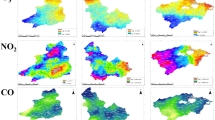Abstract
We compared the capacity to accumulate airborne heavy metals of two lichens (Flavoparmelia caperata and Parmotrema chinense) and one higher plant (Nerium oleander) at a very densely populated urban site near Naples. After 15, 45, 75, and 120 days of exposure at four sites with different levels of air pollution, equal portions of thalli and 20 leaves were collected, and four environmentally significant elements, Fe, Cu, Zn, and Pb, were measured by inductively coupled plasma analysis. To compare the accumulation rates of lichens and the vascular plant, we determined an index of relative accumulation rate of pollutants during time and the ratio between the concentrations of each element in exposed samples to that of control samples (exposed-to-control ratio). Our data indicate F. caperata as being the most suitable bioaccumulator, followed by P. chinense. N. oleander was also found to be a useful heavy metal biomonitor though not suitable as a bioaccumulator.
Similar content being viewed by others
References
Adamo, P., Giordano, S., Vingiani, S., Castaldo Cobianchi, R., & Violante, P. (2003). Trace element accumulation by moss and lichen exposed in bags in the city of Naples. Environmental Pollution, 122, 91–103. doi:10.1016/S0269-7491(02)00277-4.
Aksoy, A., & Öztürk, M. A. (1997). Nerium oleander L. as a biomonitor of lead and other heavy metal pollution in Mediterranean environments. The Science of the Total Environment, 205, 145–150. doi:10.1016/S0048-9697(97)00195-2
Bargagli, R. (1998). Trace elements in terrestrial plants. An eco-physiological approach to biomonitoring and biorecovery. Berlin: Springer.
Bargagli, R., Monaci, F., Borghini, F., Bravi, F., & Agnorelli, C. (2002). Mosses and lichens as biomonitors of trace metals. A comparison study on Hypnum cupressiforme and Parmelia caperata in a former mining district in Italy. Environmental Pollution, 116, 279–287. doi:10.1016/S0269-7491(01)00125-7.
Bari, A., Rosso, A., Minciardi, M. R., Troiani, F., & Piervittori, R. (2001). Analysis of heavy metals in atmospheric particulates in relation to their bioaccumulation in explanted Pseudoevernia furfuracea thalli. Environmental Monitoring and Assessment, 69, 205–220. doi:10.1023/A:1010757924363.
Bergamaschi, L., Rizzio, E., Giaveri, G., Loppi, S., & Gallorini, M. (2007). Comparison between the accumulation capacity of four lichen species transplanted to a urban site. Environmental Pollution, 148, 468–476. doi:10.1016/j.envpol.2006.12.003.
Conti, M. E., & Cecchetti, G. (2001). Biological monitoring: Lichens as bioindicators of air pollution assessment—A review. Environmental Pollution, 114, 471–492. doi:10.1016/S0269-7491(00)00224-4.
de Jesus, E. F. O., Simabuco, S. M., dos Anjos, M. J., & Lopes, R. T. (2000). Synchrotron radiation X-ray fluorescence analysis of trace elements in Nerium oleander for pollution monitoring. Spectrochimica Acta Part B, 55, 1181–1187. doi:10.1016/S0584-8547(00)00182-8.
de Minguel, E., Llmas, J. F., Chacon, E., Berg, T., Larssen, S., Røyset, O., et al. (1997). Origin and patterns of distribution of trace elements in street dust: Unleaded petrol land urban lead. Atmospheric Environment, 31(17), 2733–2740. doi:10.1016/S1352-2310(97)00101-5.
Espinosa, A. J. F., & Rossini Oliva, S. (2006). The composition and relationships between trace element levels in inhalable atmospheric particles (PM10) and in leaves of Nerium oleander L. and Lantana camara L. Chemosphere, 62, 1665–1672. doi:10.1016/j.chemosphere.2005.06.038.
Figueira, R., Sèrgio, C., & Sousa, A. J. (2002). Distribution of trace elements in moss biomonitors and assessment of contamination source in Portugal. Environmental Pollution, 118, 153–163. doi:10.1016/S0269-7491(01)00203-2.
Frati, L., Brunialti, G., & Loppi, S. (2005). Problems related to lichen transplants to monitor trace element deposition in repeated surveys: A case study from Central Italy. Journal of Atmospheric Chemistry, 52, 221–230.
Giordano, S., Adamo, P., Sorbo, S., & Vingiani, S. (2005). Atmospheric trace metal pollution in the Naples urban area based on results from moss and lichen bags. Environmental Pollution, 136, 431–442. doi:10.1016/j.envpol.2005.01.017.
Garty, J. (2001). Biomonitoring atmospheric heavy metals with lichens: Theory and application. Critical Reviews in Plant Sciences, 20, 309–371. doi:10.1016/S0735–2689(01)80040-X.
Godinho, R. M., Freitas, M. C., & Wolterbeek, H. T. (2004). Assessment of lichen vitality during a transplantation experiment to a polluted site. Journal of Atmospheric Chemistry, 49(1–3), 355–361. doi:10.1007/s10874-004-1251-6.
Loppi, S., Chiti, F., Corsini, A., & Bernardi, L. (1994). Lichen biomonitoring of trace metals in the Pistoia area (central northern Italy). Environmental Monitoring and Assessment, 29, 17–27. doi:10.1007/BF00546775.
Loppi, S., & Corsini, A. (2003). Diversity of Lichens and metal contents of Parmelia caperata thalli as monitors of air pollution in the town of Pistoia (C Italy). Environmental Monitoring and Assessment, 86, 289–301. doi:10.1023/A:1024017118462.
Minganti, V., Capelli, R., Drava, G., De Pellegrini, R., Brunialti, G., Giordani, P., et al. (2003). Biomonitoring of trace metals by different species of lichens (Parmelia) in north-west Italy. Journal of Atmospheric Chemistry, 45, 219–229. doi:10.1023/A:1024215023633.
Mikhailova, I. (2002). Transplanted lichens for bioaccumulations studies. In P. L. Nimis, C. Scheidegger, & P. Wolseley (Eds.), Monitoring with lichens—Monitoring lichens (pp. 301–304). Dordrecht: Kluwer/NATO Science Series.
Monaci, F., Moni, F., Panciotti, E., Grechi, D., & Bargagli, R. (2000). Biomonitoring of airborne metals in urban environments: New tracers of vehicle emission, in place of lead. Environmental Pollution, 107, 321–327. doi:10.1016/S0269-7491(99)00175-X.
Nimis, P. L., & Bargagli, R. (1999). Linee guida per l’utilizzo di licheni epifiti come bioaccumulatori di metalli in traccia. In C. Piccini, & S. Salvati (Eds.), Proceeding. Workshop biomonitoraggio della qualità dell’aria sul territorio nazionale Rome, 26–27 November (pp. 279–289). ANPA Serie Atti.
Nimis, P. L., Scheidegger, C., & Wolseley, P. A. (2002). Monitoring with lichens—Monitoring lichens. Dordrecht: Kluwer.
Rossini Oliva, S., & Mingorance, M. D. (2004). Study of the impact of industrial emission on the vegetation grown around Huelva (South of Spain) city. Journal of Atmospheric Chemistry, 49, 291–302. doi:10.1007/s10874-004-1233-8.
Sawidis, T., Marnasidis, A., Zachariadis, G., & Stratis, J. (1995). A study of air pollution with heavy metals in Thessaloniki city (Greece) using trees as biological indicators. Archives of Environmental Contamination and Toxicology, 28(1), 118–124. doi:10.1007/BF00213976.
Author information
Authors and Affiliations
Corresponding author
Rights and permissions
About this article
Cite this article
Aprile, G.G., Di Salvatore, M., Carratù, G. et al. Comparison of the suitability of two lichen species and one higher plant for monitoring airborne heavy metals. Environ Monit Assess 162, 291–299 (2010). https://doi.org/10.1007/s10661-009-0796-x
Received:
Accepted:
Published:
Issue Date:
DOI: https://doi.org/10.1007/s10661-009-0796-x




